As I mentioned before, I have a large number of high-quality, close up photographs of many of the pieces that are currently in the MFA, having had the wonderful opportunity to visit these works in person. However, due to copyright reasons, I cannot publish these as yet.
What I can do, since it is freely accessible, is comment on the chopine at the Bata museum at http://www.allaboutshoes.ca/en/heights_of_fashion/east_meets_west/, and demonstrate different aspects of construction, complete with my learning from the MFA. You'll just have to take my word for it, or I can share my photographs with you personally, as long as they are not published in any way. Additionally, if you disagree with my hypotheses and suppositions below, please do get in touch with me - we are always learning, and my research is far from complete.
A chopine, dated form 1580-1620, currently housed at the Bata Shoe Museum in Toronto, Canada. Most of the pieces I examined were constructed out of wood, except for the shorter pianelle that did not need to be so ornately carved.
|
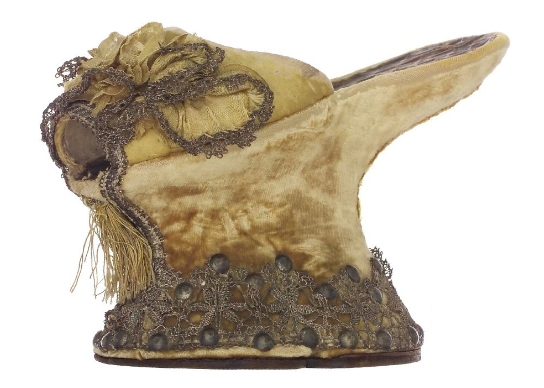
|
A close up of the sole of the chopine shown above from the Bata. If you look closely, you can see the white stitching above where the velvet is pulled underneath the base and covered by the sole, although it's difficult to tell. Regardless, this type of stitching, done through the sole and then through the surround (and I believe through the base material as well) was common on many chopines and zoccoli. Additionally, this outsole was made with a double layer of leather, the bottom layer seeming to be slightly thicker than the top. This was common on many of the pieces I examined. What is unusual about this stitching is that they do not meet one another like a normal shoemaker's stitch, also present in the MFA pieces.
|
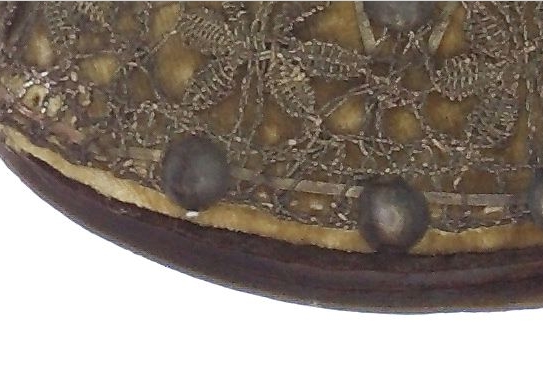
|
A close up of the back of the chopine. The key point here is the rough running stitch with the very thick thread at the back, and the fact that the edges of the velvet are not turned inward. I saw this on a few other pieces in the MFA, and I originally thought that it was conservation work, but seeing this now, it is difficult to tell. The seam would probably have been covered with a braid of some kind, to hide the stitching.
|
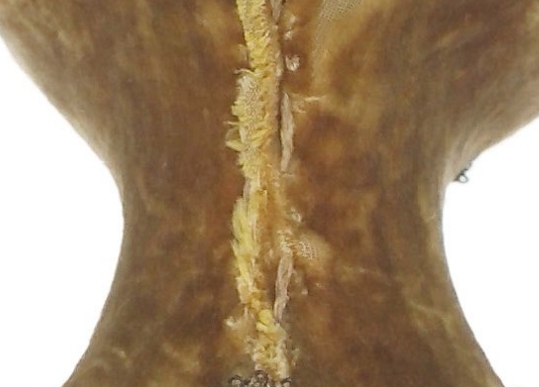
|
A close up of the insole. Note the lovely tooling on the sole, likely done with a carved metal die stamped into the insole. There is also a little bit of a velvet border around the sole. Many of the examples have a little bit of border around the insole - what this means is that the insole was cut slightly smaller than the top of the base. This was probably done for ornamentation as well as not to place the stitches on a sharp corner of the carved wooden base. Notice also the stitch marks in the velvet catching it to the insole. To have this kind of signature, I believe that the insole was awled through the side to create an edge/flesh seam, much like a turn shoe. Then the velvet was sewn onto the insole and then folded down over to hide the stitching.
|
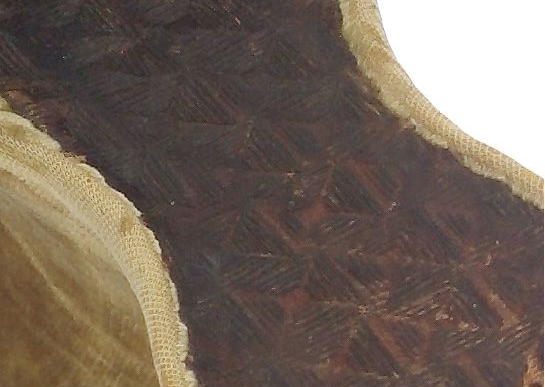
|
A close up of the velvet attached to the vamp. Notice the whip stitches used to tack the velvet down - this is very typical of several other pieces that I've examined.
|

|
A picture you will never see in the museums - the bottom of the chopine! There is a wealth of information here. Notice, first, the stitching which is done through a score, about halfway through the bottom sole. The reason for this is so that when the stitch is pulled tight, the stitches bury themselves into the leather and the wearer does not walk on the stitches, wearing them out. Additionally, you will notice a large nail in the center of the chopine. Some of the other pieces I examined also had this nail. My hypothesis for the reason of this nail is below.
|
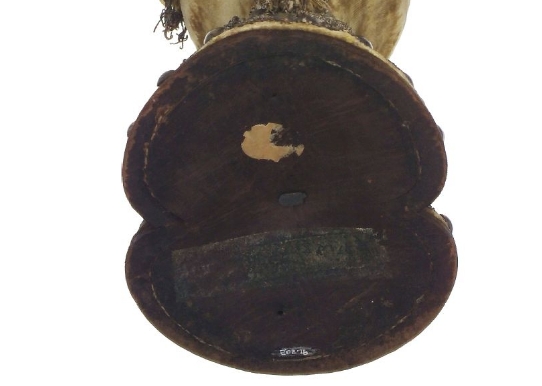
|
No, that isn't an optical illusion - the outsole is actually concave with respect to the plane of the ground, and is bowing up into the base. The nail is likely there to keep the outsole bowed up, and I've observed this same exact phenomenon (along with the coarse headed nail) on several other pieces. This does two things; the first is that by hollowing out the bottom of the base, it makes the chopine lighter to wear. We are fortunate to have one piece in the MFA in which the outsole stitching has degraded, and we can clearly observe the hollowed out base. The second is that it makes the chopine more stable. In my first attempts, all of the soles have been planar, and as a result, it makes it difficult to get a very stable chopine. By changing the contact cross section from a plane to a ring, it makes the chopine much more stable - have you ever wondered why the majority of dinner plates have a ring on the bottom? Now you know! =)
|
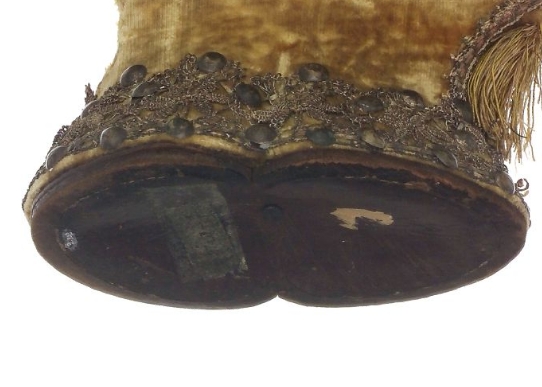
|
A close up of the stitching on the outsole.
|

|
The front of the chopine. Notice how the braid goes up one side of the front of the chopine, around the vamp, and then back down. This is only possible because the vamp reaches almost all the way to the front of the chopine.
|

|
Anderson has really done her homework when it comes to raised heels. She has detailed a very fortunate find for us! It shows a chopine in the Spanish style, with double eyelets (difficult to see if the second column is on both sides). The chopine itself is damaged and falling apart, but it clearly shows how the cork bark (normally under an inch or so thick) is held together with sharp pointed pieces of cane. Additionally, there was sometimes a metal gilt band as ornamentation, seeming to have been done with a special technique instead of with gold leaf. (Anderson 229-231).
Cork Fragments
c. 1500
Granada, Muysei Nacional de Arte Hispanomusulman Alhambra
B&W Scan from Anderson
|

|









